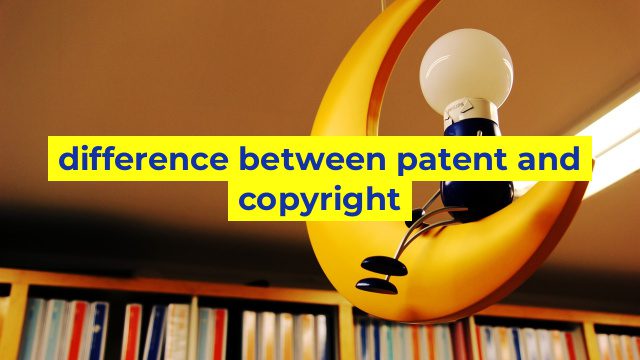The Difference Between Patent and Copyright
Both patent and copyright are forms of intellectual property rights, but there are significant differences between the two. Understanding these differences is crucial for anyone looking to protect their creative work or innovative ideas.
What is a Patent?
A patent is a form of protection granted by the government to an individual or entity who has invented or discovered a new and useful process, machine, article of manufacture, or composition of matter. Essentially, a patent gives the holder exclusive rights to their invention for a set period of time (usually 20 years from the date of filing the patent).
The goal of a patent is to encourage innovation by providing inventors with a way to profit from their inventions while preventing others from using or copying their ideas without permission. Patents can be applied for through the U.S. Patent and Trademark Office (USPTO) and are granted only after a rigorous examination process.
What is Copyright?
Copyright, on the other hand, is a form of protection granted to authors of original works of authorship such as literary, dramatic, musical, and artistic works, as well as software, websites, and other digital content. Copyright law grants the author (or owner) of a work the exclusive right to reproduce, distribute, display, and perform the work publicly.
Unlike patents, copyright protection is automatic and does not require registration with a government agency. The copyright symbol (©) provides public notice of the copyright owner’s claim to the work.
Key Differences between Patent and Copyright
Some of the key differences between patent and copyright include:
– Subject matter: Patents cover tangible inventions (such as machines or processes) while copyrights cover original works of creative expression (such as books, music, or software).
– Length of protection: Patents are typically granted for 20 years from the date of filing, while copyright protection lasts for the life of the author plus 70 years.
– Registration: Patents require a lengthy and complex application process through the USPTO, while copyright registration is optional and provides certain benefits such as the ability to sue for infringement.
– Scope of protection: Patents grant the holder exclusive rights to their invention, while copyright protection is more limited and only covers particular expressions of ideas, not the underlying concepts or ideas themselves.
In conclusion, patent and copyright are both forms of intellectual property rights that help creators and inventors protect their work from unauthorized copying or use. Patent protection is reserved for tangible inventions, while copyright is geared towards creative works. Understanding the differences between the two is essential for anyone looking to protect their intellectual property.
Table difference between patent and copyright
| Patent | Copyright |
|---|---|
| A legal document that grants an inventor the exclusive right to sell, use or manufacture an invention for a certain number of years | An exclusive legal right granted to an author, musician, artist or other creative individual to produce, distribute and sell their work for a certain period of time |
| Protects inventions, such as machines, processes, chemicals and designs | Protects original works of authorship, such as books, music, art, software and films |
| Can last up to 20 years from the filing date of the patent application | Can last for the lifetime of the author plus an additional 70 years after their death, or for a fixed period of time for anonymous or corporate works |
| Requires a detailed and specific description of the invention in the patent application | Requires an original and creative expression of an idea |
| Can be obtained by filing a patent application with the appropriate government authority | Is automatically granted to the creator upon the work’s creation |
| Protects against others using, making, selling, or importing the invention without permission | Protects against others copying, distributing or displaying the work without permission |

